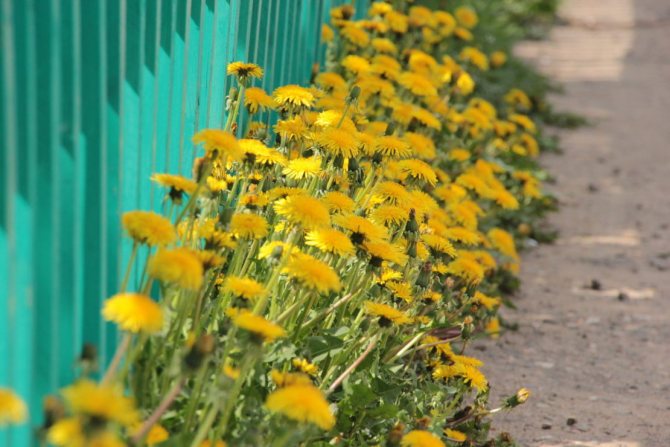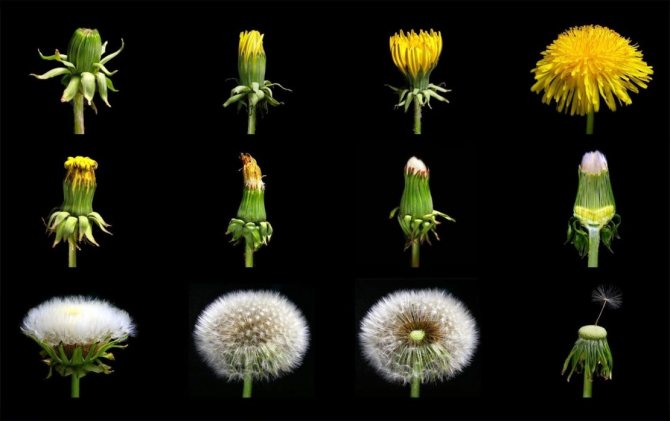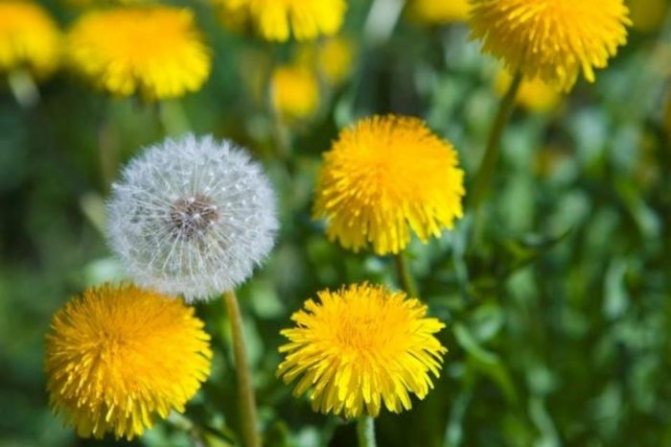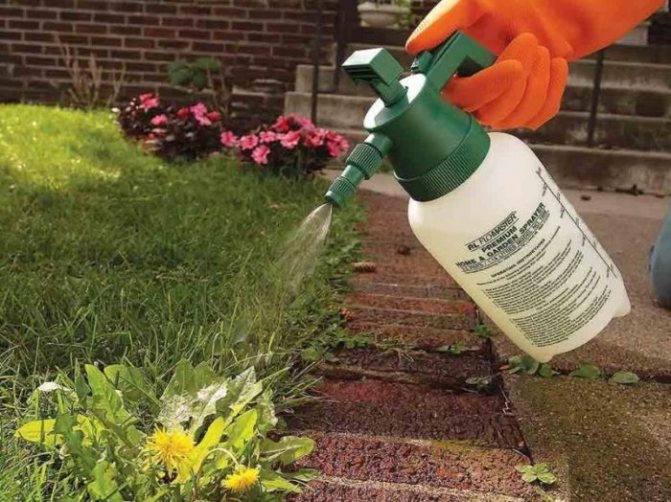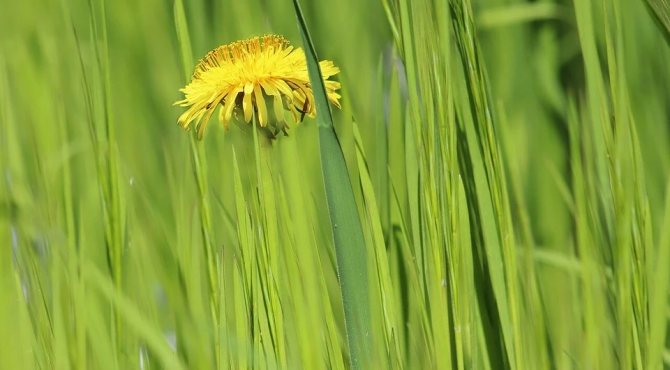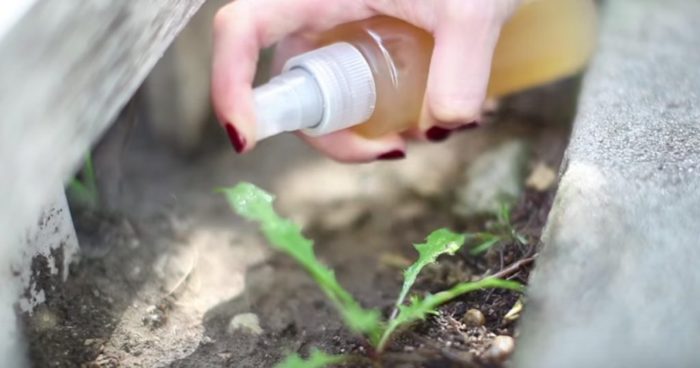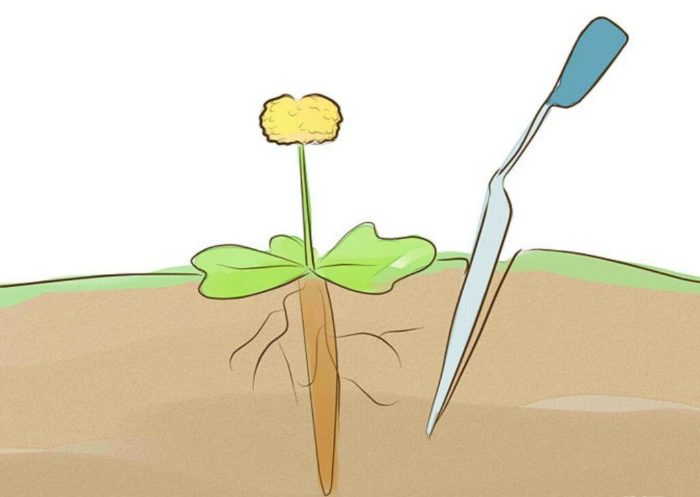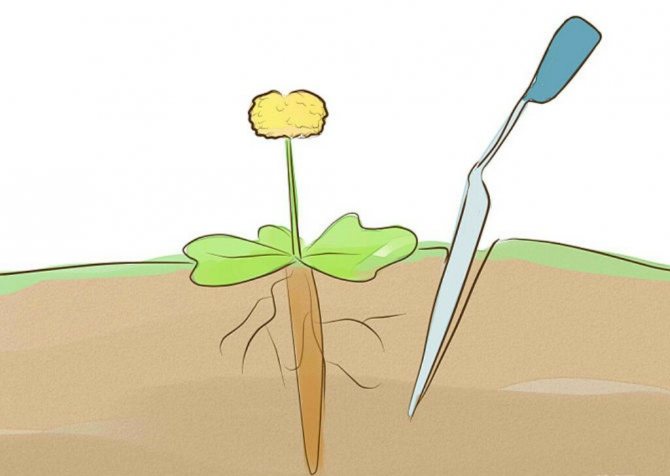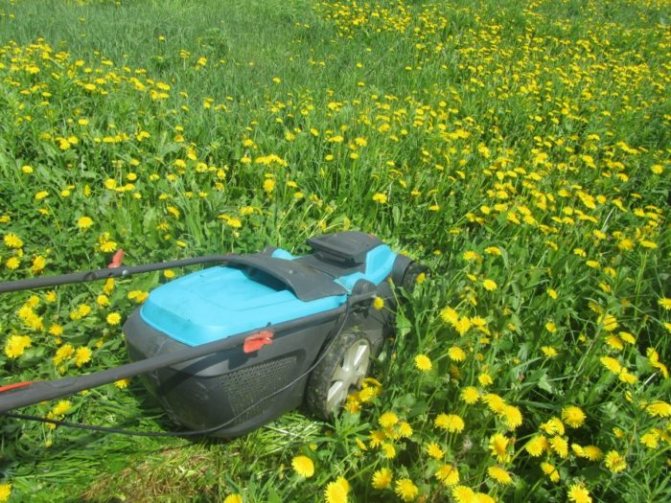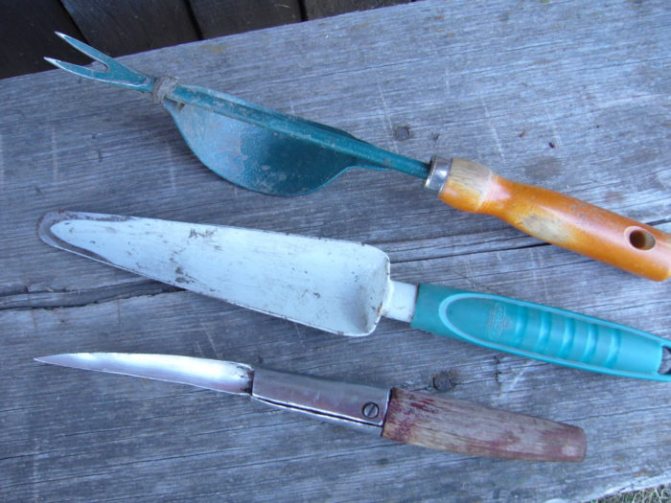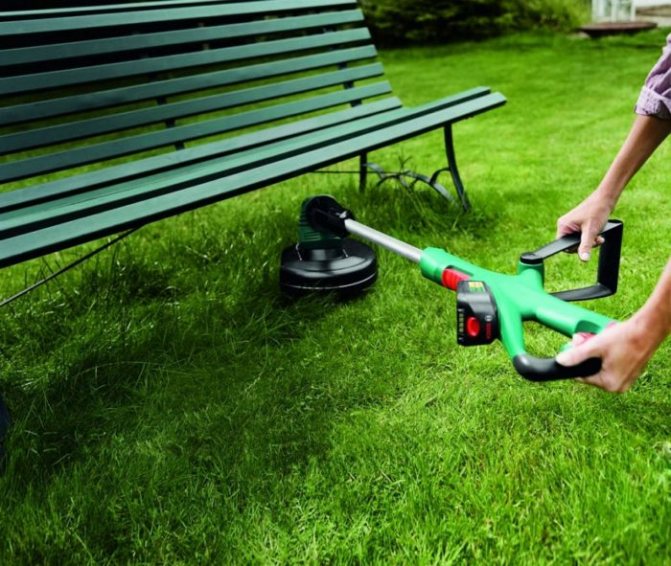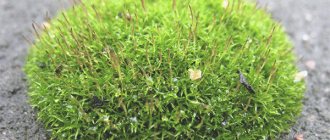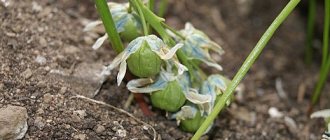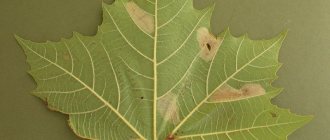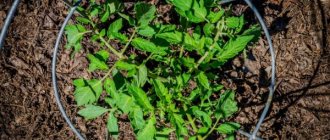Dandelion is a well-known and very common plant. His bright yellow flower caps delight the eye in fields, parks and along roadsides. If the dandelion made its way into the garden, the cute bright flower turns into a powerful aggressor that quickly floods the space. This perennial weed has a strong taproot extending up to 1.5 m deep into the ground, thanks to which it is not afraid of droughts, frosts and poor soils. The seeds formed after flowering (more than 1000 pieces per plant!), Equipped with umbrellas, are easily carried by the wind over long distances, mastering new territories.
How to get rid of an uninvited guest on your site? There are two methods of struggle: methodically harvest plants manually (mechanical method) and use special preparations (chemical). Each method has its own advantages and disadvantages, the choice must be made by the gardener himself.
Dandelions on the site - benefit or harm
Traditional medicine aficionados love dandelions for their many medicinal properties. It is a multivitamin product that contains vitamins C, E, PP, group B, especially a large amount of plant beta-carotene - a precursor of vitamin A. It has powerful antioxidant, immunostimulating and adaptogenic properties.
In terms of the amount of vitamin A it contains, dandelion is in third place after fish oil and beef liver. It is enough to eat a cup of lettuce from its leaves, and you are provided with 112% of the daily requirement for vitamin A and more than 40 times with vitamin K.
There are many minerals - potassium, magnesium, sodium, calcium, phosphorus, iron, and trace elements - manganese, copper, zinc, selenium. Low-calorie leaves go well in salads, jam is made from yellow flowers. The plant is used in pharmacy, in folk medicine, and even rubber is obtained from some of its species.
In folk medicine, the leaves, roots and sap of the plant are used for medicinal purposes. Infusions of decoctions from them are used for diseases of the gastrointestinal tract, skin diseases, diseases of the joints, atherosclerosis, diabetes mellitus.
The benefit of dandelions is that they are wonderful honey plants and pollen plants, bees visit them with pleasure. But at the same time, it is a malicious weed in vegetable gardens, which is a fairly strong allergen to both pollen and its seeds. And the overgrowth of weeds on the site sometimes becomes a headache for gardeners.
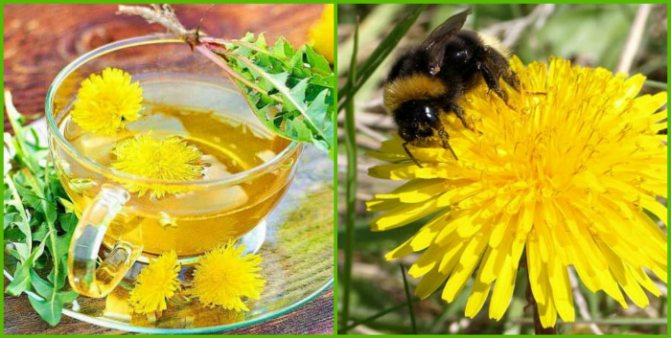
Is there any benefit from it?
Dandelion (Taraxacum officinale) is a medicinal herb with great health benefits. The juicy fleshy roots contain active substances - powerful antioxidants, greens contain a lot of vitamin C. Dandelion plant raw materials are used as a diuretic, tonic and tonic.
It is useful for diabetics and people who are weakened after undergoing operations. Green leaf paste is used to treat wounds, burns, and is used in cosmetology.
An excellent healing drink is prepared from the dried root, which is not inferior in taste to coffee. You can make a beautiful and tasty jam from the flowers. Craftsmen have learned how to make dandelion wine, with a very pleasant unusual taste. Fresh young dandelion leaves are eaten in spring vitamin salads, along with nettles and dandelion.
Tags: aggressive growthallergenmedonosseeding
How to destroy dandelions on the site once and for all
In fairness, I must say that you will not be able to completely get rid of a dandelion. Their seeds on their parachutes are easily carried from neighboring gardens and roadsides for many kilometers around. So getting rid of them forever and irrevocably will not work, no matter how hard we try.
First of all, you need to understand that the fight should be carried out in a comprehensive manner, using various methods, and regularly throughout the season. As the scattered seeds sprout again throughout the summer.
But it is quite possible to reduce their harm on your site by ruthlessly removing them. For this, mechanical, chemical and preventive methods are used. It is necessary to understand that all preventive and control measures must be carried out regularly. There will be no sense from one-time procedures.
By the way, there is now a law on weeds. According to the Land Code of October 25, 2001 N 136-FZ (as amended on December 25, 2018), (as amended and supplemented, entered into force on 01.01.2019), article 13 (Content of land protection), land owners must maintain their own the area is clean, timely removing weeds from it. And now they are also fined for weeds. If a neighbor complains about you that the weeds "move" from you to your site, you can be fined. The amount of the fine can go up to 1.5 thousand rubles, for many it will be a tangible amount.
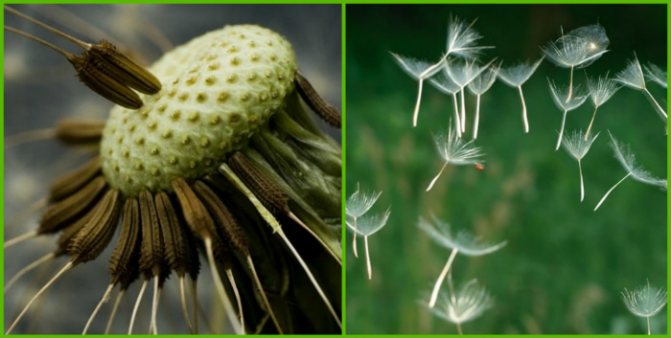

What you need to know about dandelion weeds
The enemy must be well studied, only then to choose effective methods of struggle. Dandelion is an unpretentious perennial from the Aster family. It appears very quickly on the lawns after the snow melts. Blooms several times per season. Moreover, each time the yellow flower baskets turn into a lush white cloud of flying seeds. The wind carries them 2-2.5 km and further. Once in the soil, they take root well and take root.
The weed's rhizome is strong and long. The central root goes deep into the ground up to 25-35 cm. If even a small fragment of it remains after weeding, the plant will return to life. Moreover, this time it will increase the number of peduncles. The perennial is actively growing, manages to scatter thousands of seeds per season. Therefore, it "spreads" very quickly.
How to remove dandelions in the garden using herbicides
With the arrival of spring and the onset of the summer cottage season, many gardeners-gardeners have the question of how to deal with weeds - dandelions. There are various ways, all of them require a certain investment of time and labor. One of the options is the use of chemicals - herbicides. Among the effective and efficient means are
- Roundup,
- Tornado,
- Lontrel,
- Agrokiller.
There are also herbicides of a narrower action, aimed at combating precisely rhizome weeds. These are Sniper, Lintur, Metafen, Killex, Hacker, etc.
The use of these funds has many advantages, including efficiency and a short processing time. Among the disadvantages is toxicity for nearby useful plants and humans.
These are universal means of continuous action. After a single application, you can count on complete cleansing of the land from all types of weeds. To do this, you must use the drug correctly, in full accordance with the instructions.
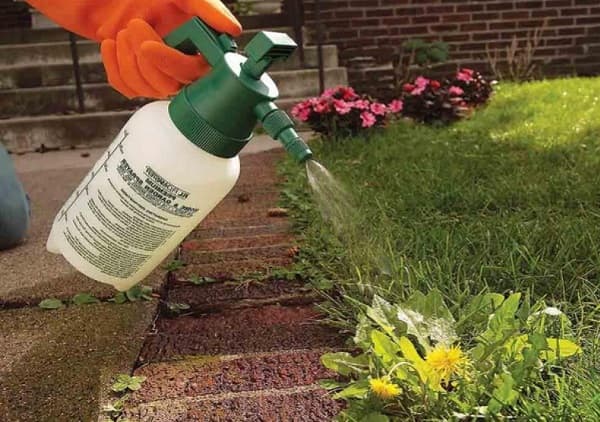

The mechanism of action of herbicides
- The agent is retained on the plant by means of an adhesive additive;
- Active substances disrupt metabolism by blocking vital processes. The plant first turns pale, then turns yellow, dries up and dies;
- It takes at least 6 hours for the agent to be absorbed into the plant. Therefore, use the product 4-6 hours before treatment. After the product has been absorbed, it takes a week for the product to gradually spread throughout the plant, right down to the root system.
- The weeds first turn pale, then turn yellow, gradually dry out, and die after about a week.
For use, the product is diluted in water and sprayed with weeds. If a weed in the garden grows next to a useful plant, then it must be covered with some kind of screen (a piece of cardboard, plywood, etc.) or the plant should be anointed with a brush dipped in the product.
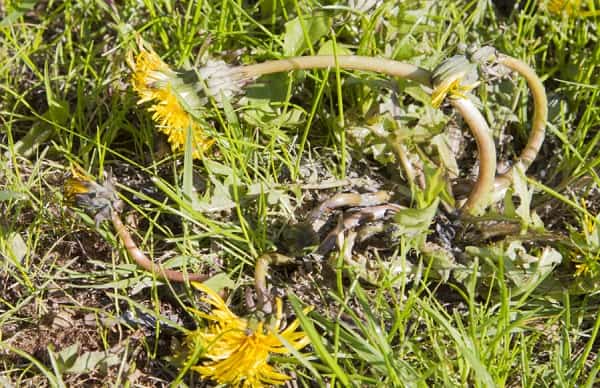

Chemicals
Herbicides are of great help in this matter. They solve this problem radically and in a short time. Their use sometimes gives negative consequences, but if it is difficult to solve the issue in other ways, then they prefer the lesser evil. Again, herbicides are subdivided into:
- continuous action;
- selective.
The first destroy everything that grows nearby.
Therefore, you need to apply them:
- in the spring, before sowing seeds;
- in the fall, after harvest.
When using these drugs, make sure that they do not get on fruit, ornamental shrubs and trees. This group is distinguished:
- Tornado;
- Roundup;
- Lontrel.
Selective drugs do not pose a danger to neighboring plants. Therefore, with their help, dandelions can be removed from any lawn without affecting the grass.
These funds include:
- Killex;
- Lintour;
- Sniper.
Lintur is the most harmless to plants, therefore it is used during their active growth in the garden and vegetable garden.... In contrast, the Sniper is applied with a point applicator. The drug makes its way into all aerial parts of the weed and roots, killing them. After application, the results will not be long in coming. After 7-10 days, the process of dandelion death will begin, and in a month the dacha will be cleared of weeds. And only on seeds the power of the herbicide does not apply.
How to get rid of dandelions in your garden
Stock up on patience, a tool and you can start fighting a malicious weed.
- Mowing lawn mower, trimmer or simple mowing machine. You need to mow dandelions before they bloom. Even if cut, flowers continue to “live” anyway. Their seeds are later spread around the site anyway. In addition, mowing flowering weeds does not guarantee that the plant will not grow back.
Keep in mind that a dandelion will stop growing if removing the plant removes its growth point, which is level with the ground. Otherwise, the plant, like a hydra, will grow back, and there will be more peduncles.
- Digging up the weeds together with the root. This is a more laborious process, especially when the site is large, but the safest and easiest way. Usually, use a regular shovel or a special dandelion picker. It can be purchased at specialized garden stores.
Or use a DIY fixture like this video.
- Petssuch as rabbits, piglets and chickens are very fond of dandelions. Let them out on a weedy plantation and they'll save you the extra work pretty quickly.
- Mulching Is a fairly effective way to get rid of not only dandelions, but in general from all weeds. For this purpose, covering material, cardboard, dark film are used, they cover the aisles. In the dark, a plant without sunlight does not photosynthesize plants, they do not have the ability to grow, therefore they quickly die.
Weed control chemistry
Herbicides are substances that kill various plants in the garden, which interfere with the growth of fruit crops and reduce their yield. If the site is completely filled with dandelions, then only chemicals will come to the rescue.
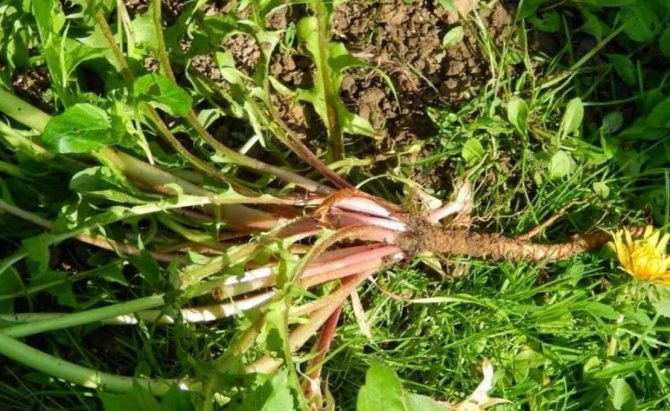

Lintour
Systemically affects all parts of plants. Oppresses physiological processes. The agent is sprayed on the stems and leaves, through which it penetrates inside, goes into the roots along the main trunk.


The first signs of imminent death of weeds appear on the 7th day, and death after 3-4 weeks.Phytotoxicity is not high, therefore, plantings near it will not be affected. Before processing, no action is taken with the grass. No pungent odor, well soluble in water.
Tornado and Roundup
Broad spectrum herbicides. Spraying a plot with such a means, not only pests will die, but also specially planted flowers, vegetable and fruit shrubs. Dilute the drug with water and water only the places where the dandelions grow before planting or after harvesting the fruits.
Folk ways to deal with dandelions in the garden
Our gardeners are resourceful people. Not wanting to use chemistry, they come up with more radical but effective ways to destroy dandelions. Here is some of them.
Acetic acid... They use ready-made 9% table vinegar, evaporating it to a higher concentration, or vinegar essence, diluting it by half. Curl the solution into a spray bottle and spray the entire plant. Hydrochloric acid can be used instead of acetic acid. A mild acid solution is sold at a hardware store.
Take precautions when handling acids. Avoid getting acids on exposed areas of the body and mucous membranes. Wear protective gloves and goggles.
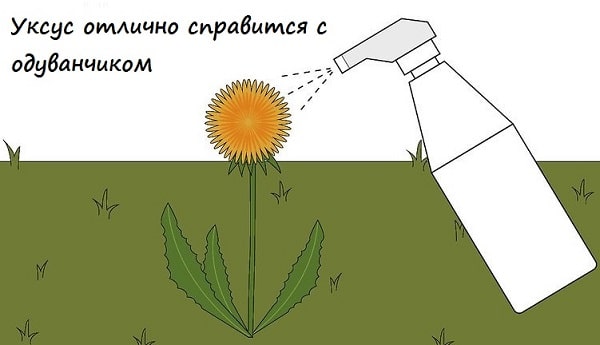

Edible salt... Place a handful of common salt on the spot where the dandelion begins to sprout. The weed will quickly die. However, avoid spilling salt on neighboring vegetables.


Boiling water... Pour boiling water over the middle of the plant, the plant will die instantly. An even better result if you pour boiling fat onto the central outlet with the peduncle.
Gas-burner... Light the burner of the cylinder and burn the flowers or already the heads with seeds with fire. When using this method, be extremely careful with fire! Observe fire safety rules, do not let children use the burner.
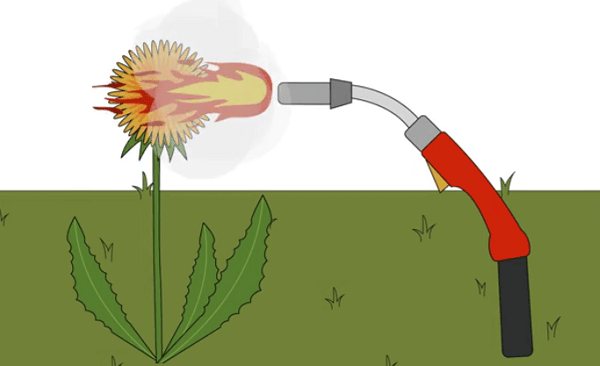

Mechanical method of removing weed
The job is to carefully weed and destroy the plant. Moreover, an ordinary hoe cannot solve the problem. The greens cut down by the hoe grow back very quickly. The plant itself reacts interestingly to the regular weeding of greenery - it ceases to form a long stem, and flower buds are poured at the very surface of the earth. A similar picture is observed with regular mowing of the ground part of the weed with a trimmer or mower. His desire for survival is simply amazing.
Single dandelion plants can be conveniently dug in and removed with a long and sharp knife, cutting the root as deep as possible underground. After it is dried in the sun and burned, or carried away in compost. To prevent the germination of weeds, plant residues are covered with a black mulch film, spilled with a solution of Baikal or other bacteria.
During the spring and autumn digging of the site, the roots of the weed are carefully selected and burned.
Important! You should not process the area clogged with dandelion with cutters, which usually stand on walk-behind tractors. The cutters will chop the roots of the weed into many pieces, and each can grow a new plant! Thus, the number of harmful herbs will only increase.
You can water weeds with a strong solution of salt (a glass of salt in a bucket of water) or acetic acid. It is important to be careful not to accidentally splash liquid on cultural plantings, this will destroy them.
Preventive measures - how to deal with dandelions
What if dandelions grow on the site instead of grass? It is difficult to deal with the appearance of dandelions in a large area, but you can resort to preventive measures.
- Dig deep into the area in the fall, this will destroy the young shoots of the weed and their freezing in winter;
- Sow the dug areas before winter or empty areas with green manure. Do not leave "bald" areas, dandelions will sprout on them right there;
- In the spring, before sowing seeds and planting seedlings in the beds, remove the germinated seedlings, later it will be more difficult to dig them out of the ground;
- Mulch vegetables in the beds with grass or other material. This eliminates the possibility of dandelion seeds getting on the soil and their germination.
- Mow the lawn to a height of 6-8 cm, it will be more difficult for seeds to germinate, and their shoots will not receive sunlight and will not be able to germinate.
- Don't leave dandelions where they were dug. Do not think that they will dry out. It will rain and the roots will grow back. Also do not leave on footpaths. With the soles of your shoes, you can easily spread the seeds to new areas.
Description
Common dandelion (Latin name Taráxacum officinále) is a perennial herb belonging to the Aster family. It is found everywhere in nature: in the cold, temperate, subtropical zone, even in the tundra. Likes to grow on lawns, forest edges, on the side of the road, in gardens, meadows, along the banks of water bodies, near housing, on lawns and flower beds.
The plant has a long - about 60 cm - vertical root, about 20 cm thick, brown on the outside and white on the inside. Leaves are oblong pinnately dissected near the root, collected in a rosette. Its leg is a long hollow tube, the top of which is crowned with a round basket with a diameter of 2 to 5 cm. It is painted bright yellow.
The fruit is a seed. They are easily and quickly spread by the wind by seeds, scattering with the help of fluffy umbrellas over long distances. They hatch in slightly damp ground. The sap of the plant is thick milk. Dandelions bloom in April, May, early summer. Its fruiting is long: it begins in June and lasts until mid-October. One flower gives up to 200 seeds.
Prophylaxis
It is necessary to carry out preventive measures regularly, since dandelions spread rather quickly throughout the territory and then it will be much more difficult to deal with them. The best prevention method is regular monitoring of the general condition of the site and proper care of it.
Prevention does not require the implementation of complex measures, since it is enough to follow the following simple rules:
- Do not remove the grass in the area, but simply cut it. This will become a real obstacle to the formation of new weeds.
- Make sure that there are no empty areas on the lawn. This location may be ideal for dandelion sprouting. If you avoid empty areas, then in the fall they need to be sown with grass again.
- The height of the clipped vegetation should be 7-8 cm. Due to this, the grass will become an excellent soil protection, and it will be difficult for dandelion seeds to root, because there will be not enough sunlight.
It is also worth learning more about how to properly carry out preventive work to remove roots, and how to get rid of the roots of trees on the site.
Harm
If you look at the area covered with yellow flowers, you hardly get the impression that these flowers are doing any harm. But in fact, they are quite dangerous for many plants. If you do not get rid of unnecessary plantings in time, then they will continue to grow, multiply, thereby taking away useful substances and nutrient moisture from useful plants.
Dandelions are plants with long-term vitality and rapid growth. If you do not pay due attention to weed removal, then you should not wait for a good harvest.
In addition, an area richly sown with dandelions is often the cause of the development of serious health problems. This is due to the fact that, at first glance, this cute plant is allergenic and can lead to the development of such a serious illness as bronchial asthma. So you need to be careful with this plant. But how to remove reeds on the site, and which chemicals should be used in the first place, is described in the article at the link.
Electric Dandelion Burner
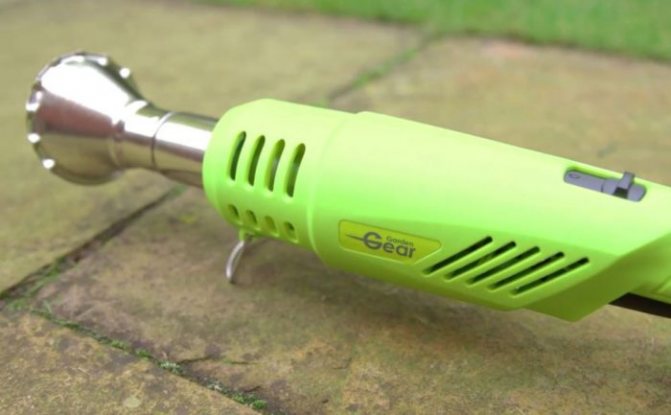

Recently, electric weed burners are gaining momentum in use. And this is legitimate. Modern devices have a stylish design, light weight, convenient and easy to use. Electric weed killers deal with the most vicious perennials, in particular dandelions.
The devices are considered to be economical and safe as they use power supply in the absence of flame, gas or chemicals. The conical nozzle blows hot air directly to the weed. Enough 10 seconds of exposure - and the hated "enemies" of the lawn perish.


Electric weed killers are very popular manufacturers:
Garden gea (Great Britain), Gloria Thermoflamm bio Electro (Germany), Hozelock (Great Britain).


